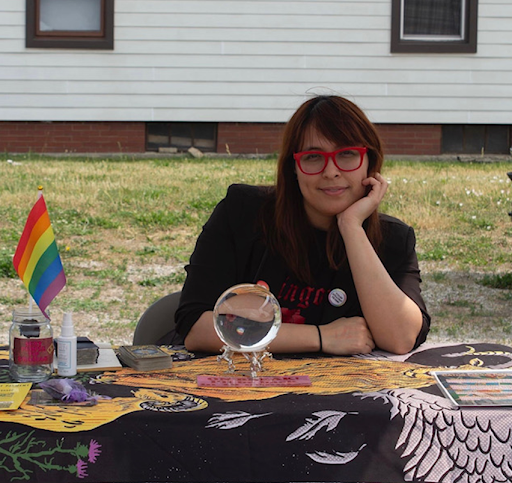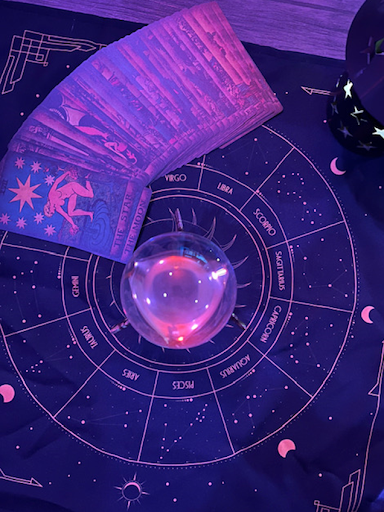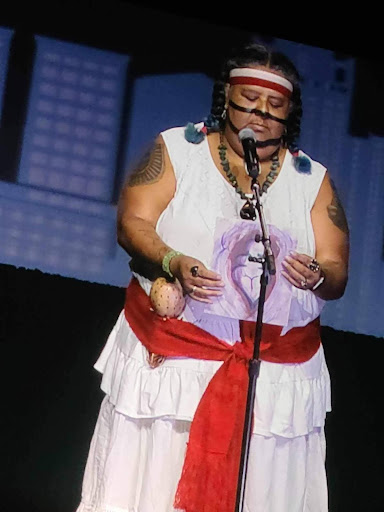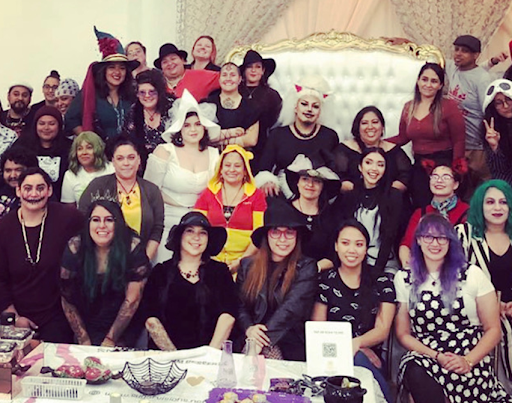Four Chicago brujas and mystics describe what being a bruja means to them and the powerful culture and healing behind it.
“You’re a witch,” my bruja cousin said, “you just haven’t harnessed your powers yet.”
I wouldn’t call myself a bruja, or “witch” in Spanish, but I’m spiritual. I cleanse crystals, use pendulums and feel the spirit of my abuelita when my cousin reads my tarot cards. I’ve always wanted to dive deeper into it, but never knew where to start. Brujeria draws from so many syncretic cultures including Spanish, Caribbean, African, Dutch and Indigenous Latin American magical practices that I’m spoiled for choice.
For many latines, being a bruja is more than being a Hocus Pocus wiccan witch, and it’s not as dark and mal-intentioned as people may assume.
Chicago is buzzing with mystics and magical brujas that provide inspiring stories, guidance and powers. Many of them look up to polytheistic goddesses, ground with mother nature, and for one bruja in particular, run a bakery business, too.
Located in Logan Square, Gatos Locos is a psychic microbakery run by Kat Rubio, a self-described “kitchen witch” who has been practicing brujeria since she discovered her clairvoyant abilities at six years old, adding baking into the mix soon after.
Rubio’s magical gifts surround fortune telling, with scrying being her first skill. Scrying describes an array of fortune-telling practices using crystal balls, wax, water, mirrors and more. She also experiences clairvoyant empathy, meaning she can physically feel the pain others will soon experience.
“I am a clairvoyant empath,” said Rubio. “I also feel ailments that might happen to you… like my right ankle starts to really hurt out of nowhere during our session … then I know something’s going to happen to your ankle, and then it does actually happen.”

Kat Rubio (Photo courtesy of Kat Rubio)
By using her crystal balls, Rubio sometimes sees images of when these specific events might happen, such as which season.
The origins of her psychic abilities stem from early childhood. Rubio began scrying with water and now uses crystal balls as well as traditional Mexican loteria cards, which are popular among bingo gameplay between many latines. Rubio uses them as tarot cards, analyzing the pictures, symbols and messages they give her about a client.
“It’s an old way of reading your future,” she said. “It’s divination.”
After obtaining a baking and pastry degree with a minor in nutrition, Rubio opened Gatos Locos in 2015, incorporating Latine culinary flavors into her unique and savory pastries.
“Cinnamon, clove, we do a lot of that.,” said Rubio. “We do chile sometimes… we have tamarind, we have all kinds of things.”
Though she doesn’t necessarily sprinkle spells and potions into her batter, she does believe eating can fulfill more than physical needs.
“It’s like feeding your soul and also feeding yourself,” she said. “Because when you eat something, you’re never sad.”
Rubio uses her desserts as a coping mechanism as well, especially after a draining fortune telling session. Seeing into people’s futures and lives can take a huge emotional toll not only on the client, but the reader as well. To alleviate her anxiety and maintain mental wellness after Rubio indulges in her THC infused sweets after performing limpias (cleansings) of energy before a session.

Tarot spread (Photo courtesy of Kat Rubio)
“I would say that that does calm me down in order to be really seeing everything clearly,” Rubio said. “And I’ve also gotten inspirations that way… I’ve thought of different flavors.”
Clients also find benefits in bringing their own weed or eating her THC pastries during sessions. Studies demonstrate that cannabis use can help alleviate depression and anxiety for people long term, emotions many clients may experience when getting read.
“It just helps them out a lot,” Rubio said. “With processing things that I’m saying to them.”
One of the most important values Rubio maintains during her sessions is providing an intimate and safe environment for clients. Many Black, Indigenous People of Color (BIPOC) prefer culturally sensitive, aware and likeminded therapists, often people from their own racial identity. Unfortunately, these services can be hard to find, as 84% of psychologists in the United States are white, sometimes leading to a cultural mistrust between clients and mental health professionals.
Culturally alternative mental health practices in the holistic and spiritual realms therefore serve an important purpose for the BIPOC community, offering more accessible and trusting spaces for emotional healing.
“I want to provide a safe space for people like us,” Rubio said. “For any people of color, and the LGBTQ community is definitely huge for me.”
Chicago is home for a plethora of other brujas focused on social equity and justice, many of which take inspiration from their spiritual beliefs and practices to guide their journey. Bruja and ordained priestess Laura Gonzalez focuses much of her spiritual work on social advocacy, acceptance of queer folks and healing the wounds of colonial racism within the witch community.
Based in Bridgeport, Gonzalez leads women’s circles with her skills in practicing Mexican folk magic, the goddess tradition, native philosophies and North American paganism. She offers tarot reading services along with dream interpretations and classes surrounding her practices.
Born in Mexico, Gonzalez remembers possessing magical gifts from an early age, many of which were perceived as malicious.
“When I was very very young, I had an accident,” said Gonzalez. “I choked on a chicken bone… I was dead for a minute and then came back. Chances are, that is the root of my psychic ability… culturally, people believe that if you cross the threshold, you come back different.”
Gonzalez comes from a spiritually open family, with her father being a “newager” and her mother being a natural witch with an innate ability to sense nature’s cycles, manifest healing and abundance.
Newage is an eccentric and broad range of spiritual beliefs and practices which gained popularity in the 1970s. Embraced by Western societies, the primary beliefs surround the idea that the human body transcends physical form by connecting with the mind and spirit, forming a “higher self” that is both human and part of the divine universe. Many newagers are spiritual advisors who guide the human mind through natural intuition.
Gonzalez’s father taught her how to heal with her hands around nine years old, and she’s been practicing cleansings since she was around 13. Like her father, she possesses heightened intuition, her strongest psychic ability being precognition. She uses this gift to read and analyze people’s life stories and predict events. Gonzalez has predicted everything from the weather to animal attacks on her friend. Her most intense prediction was of a natural disaster in 1989.
“The biggest one [prediction] was an earthquake in ‘89,” Gonzalez said. “I told a friend what time the earthquake was going to be… when it happened… he saw me and said before me, ‘Witch! Here’s the devil!’… and never talked to me again.”
Despite a close-knit immediate family, her community feared her magical skills and taunted her. As is common for many witches, the fear of magic’s ambiguity, unknown past, stereotyped media portrayals and infamy for destruction keeps many people closed-minded to the array of positive attributes of being a bruja and possessing powers.
“At thirteen, I started asking my youth groups, ‘Why do I see things? Why can I prophesize?’ and the answer I got is because ‘you’re a woman, you’re the devil,” said Gonzalez.
After years of working in factories and as a hostess and cashier in the United States, Gonzalez decided to take the advice of her loved ones and open up a tarot reading, limpia and dream interpretation service. She’s built a loyal community and now shares her teachings and skills with people, blessing and cleansing energies with them.
“I help them unscramble their present,” Gonzalez said. “It helps people frame their present, and it helps guide making decisions. I give my advice with all the knowledge that I have being trauma informed, being culturally informed [and] being brown in the United States.”
Gonzalez’ passion for cultural sensitivity and social advocacy stems from her devotion to the Goddess Tradition, for which she was ordained a priestess by the Fraternidad de la Diosa – Templo de la Diosa. She is also the founder and priestess of the Fraternity Goddess here in Chicago. Gonzalez’ greatest passion is teaching, where she gives lectures bilingually both nationally and internationally. As part of the Parliament of the World Religions, Gonzalez also works to promote interfaith unity.
“The goddess tradition focuses on connecting with Mother Earth and nature,” Gonzalez said. “The physical manifestation of the cosmos is the physical manifestation of the goddess… the goddess is with the galaxies, the cosmos, the universe, the known and the unknown.”
The Goddess Tradition also inspires and guides Gonzalez on her constant quest for social justice. Gonzalez is an advocate for addressing mental illness, suicide prevention, the LGBTQ+ community, BIPOC and various feminist movements.
“The majority of goddess practitioners are activists,” she said. “We’re the ones screaming for everything.”

Laura Gonzalez at the opening ceremony for the Parliament of World Religions 2023 (courtesy of Laura Gonzalez)
Listening to Gonzalez’s words of wisdom resonated with me, providing terms for experiences I shared with her, but could never put a name to. Growing up in a Lutheran environment, queer intolerance and patriarchy were among the values I adhered to with blind faith. Altar bread dissolved in my mouth and wine seared down my throat as I took in the body and blood of Christ, never questioning why.
Now, I see my own reflection in the Goddess Tradition, possessing a fiery tongue and radical social views. My spirituality is ever changing; it ebbs and flows like the universe and as Gonzalez says, it screams for justice.
Gonzalez emphasizes the importance of the origins of these chants for equity and justice, which date back to European colonization. There is a racist divide between “white” and “black” magic in the world of witchcraft that many people don’t know of. Typically, black magic is viewed as the poster child for malicious and harmful spells and hexes, but it’s true roots stem from a necessity to defend rather than attack.
Many brujeria practices combine Afro-diasporic, Dutch-Caribbean and Roman Catholic practices due to colonization. Hoodoo, Voodoo, Brua, Obeah, Quimbois and Santeria are among the many that still thrive today. Before Christian proselytization, many enslaved and conquered natives of Latin America and the Caribbean utilized their Indigenous magic to combat the oppression of white colonists.
“The oppressed, the colonized, had to use magic,” Gonzalez said. “Not praying on churches and aesthetic buildings, but digging their hands in the ground and burying dolls… people didn’t know other than Christianity, so the oppressed had to utilize those icons… voodoo, hoodoo, santeria… they had to survive.”
Colonial Haitian natives unified themselves against colonizers through Voodoo, a spiritual religion involving charms, spells and dolls. Mayan and Aztec women were seen as physical healers, reflective of the moon goddess of fertility. Indigenous Brazilians used herbal medicines to heal themselves of the diseases Europeans brought to their land which had no Western cure at the time.
European colonizers developed the concept of “witchcraft” from old demonological texts defining it as “influencing one’s fate through a pact with the devil,” according to historian Nicole von Germeten. They then used this concept as a colonial weapon to demonize spiritual healers and natives as well as to implement a Christian-based judicial court to persecute the colonized.
Therefore, the magic of these Brown and Black communities became known as magic of Black people and magic of the devil, with a racist and negative connotation due to European-dominated historical writings.
Nonetheless, brujas stride with pride when embracing different sectors of magic, creating beautiful and amorphous mixtures of spiritual beliefs, ancestral history and sorcery. Though seemingly paradoxical, Christianity is often embraced as part of brujeria as well.
Chicago-based bruja Charlene Reynoso, otherwise known as “Que Mala Bruja,” understands the tight-knit community and culture behind brujeria, syncretizing many different spiritual practices together herself. Like Gonzalez, she faced ridicule for her gifts but now thrives in her bruja community and identity.
Reynoso has been reading tarot for 23 years, ten of them being professionally. Her mystic background stems from her highly spiritual family, primarily her abuelita, who led prayer circles and practiced divination.
“As a little girl, she would show me how to attend the altars, give offerings, how to recite the prayers, how to recite the rosary,” said Reynoso. “So I’ve always had a very strong spiritual influence since early on in my life.”
From an early age, Reynoso recalls being taunted with the word “bruja” similarly to Gonzalez. Her abuelita skeptically warned her of the dangers in associating with this term, though Reynoso decided to take the risk of redefining it.
“When I told her I was being called [a bruja] … she was like, ‘That’s not a compliment,’” Reynoso said. “And I was like, ‘Well, I’m changing that.’”
Reynoso has incorporated all facets of her cultural and ethnic identity into her brujeria, which is one of the most important aspects of her practice. By morphing her brujeria to what she wants it to be, Reynoso redefines the stereotypes and judgments behind the identity. She finds building ofrendas (altars) to be a rich place for syncretism.
“You might see a cross and a rosary, but you might also see mala beads,” Reynoso said. “I feel like it kind of marries everything together, because it’s honoring that we have so many ancestors that work through and practice so many different things.”
Along with personal benefits, one of the most fulfilling things for Reno is providing community wellness support with her tarot readings and celebrating the healing gifts of her bruja friends. Many Latines in Chicago cannot afford health insurance, making mental and emotional wellness unaccessible. In fact, Latines are four times more likely to go uninsured than white Chicagoans, so alternative medicine and mental health practices can be very useful and economical for Latines.
“The community has always had people who are the curanderas, the people who are the healers … who you go to for spiritual advice, for emotional and mental advice,” said Reynoso. “These are things that build spaces where therapy and mental-health modalities were not available to our people.”
Reno specifically helps people obtain clarity on their life paths, often reading cards for relationships and work prospects. She finds that engaging with her community and providing healing sources reflects a larger collectivist pattern within Latine and Black cultures.
“When we move into this hyperindividualism that comes from white supremacy, that comes from whitewashed spirituality, it teaches us that … all you need is you… you can manifest your way out of poverty,” said Reynoso. “That’s not how our practices ever worked, and I think that’s something we’ve tried to refocus on from the beginning.”
As a queer person, Reynoso has successfully found accepting queer bruja communities in Chicago, many of which congregate at her monthly witch market, Witch-o-rama. The vibrancy of these mystic vendors and bruja drag queens has evolved into a large family. Rubio is also a part of the Witch-o-rama family.

Witch-o-rama community (Photo courtesy of Kat Rubio)
“The wiccan community and pagan community are incredibly receptive and open to queer folks,” she said. “There is just this wonderful acceptance of people of all sexual, gender orientations … I’ve met matriarchs and elders in other houses.. and the Madrina of that temple is a trans woman. That exists in Chicago.”
Young mystics in Chicago are finding their way into bruja communities like Reynoso’s, embracing and normalizing alternative forms of religious and spiritual practices.
Mayra Gutierrez, a student at the University of Illinois at Chicago, doesn’t identify as a bruja, but is exploring her skills and talents within it. After leaving the Catholic church, she began reading tarot and oracle cards for her friends, possessing a natural intuition at analyzing symbols and life paths.
“My religious upbring was Catholicism,” Gutierrez said. “I stopped because I started realizing the mess that my religion had and how I didn’t align with many of the values I had.”
Tarot reading has many benefits for people including Gutierrez, as they can provide immense clarity on life choices and what someone needs to hear.
“Tarot answers a lot of your questions in a way that makes you reflect on your current situation and how you can improve yourself,” said Gutierrez.
Psychological practices and coping strategies also play a big role in her spiritual work, most notably shadow work, a process of uncovering repressed parts of your unconscious mind. Social media has become a catalyst for the popularity of The Shadow Work Journal, a self-help book building upon this psychology practice which Gutierrez uses as a mindfulness tool.
“It’s for you to improve your life,” said Gutierrez. “For you to live up to your best potential, your highest power … it’s all centered around you.”
Though Gutierrez doesn’t practice Catholicism, she acknowledges the syncretism many mystics and brujas practice with various forms of magic.
“A lot of Latinos who are spiritual tend to have ties to the Catholic church,” she said. “They generally refer to Jesus Christ or the Virgin Mary … they manifest, they keep them in mind … they find a way to intertwine them both.”
Long time practitioners of brujas offer us a wide variety of paths and niche specialties as younger mystics. Many young Latines, like Gutierrez, may grow up with a passion for readings, while others, like myself, may focus heavily on interpersonal cleansings and crystal healing. Some may even be kitchen witches, as Rubio points out. That’s one of the most beautiful things about the brujeria culture — how open, accepting, and fluid it is.
What I most admire is the consistent social activism, inclusivity and cultural awareness brujas possess. All of the brujas I spoke with come from vastly different parts of the city, from Logan Square to Bridgeport to North Lawndale, and yet they all encourage and support the power of solidarity and community healing.
“These types of spiritual practices are very revolutionary in that they bring together all types of people to empower them,” said Reynoso.
Rubio, Gonzalez and Reynoso all encourage people interested in spirituality to follow their hearts and explore it with them. There’s often a misconception that one has to have spiritual “gifts” or a long lineage of indigenous brujeria, but anyone can become a bruja if they truly seek to.
“I’m here for anybody who needs insight on anything and wants to know their future,” said Rubio. “I’m here to give them all the sweets they want, and I’m there as a safe space for everybody.”
Those interested in Rubio’s work can listen to her Spotify podcast Spill the Tea! With Kat Rubio, where she unveils anonymous confessions and gives spiritual advice.
For Gonzalez, her work focuses heavily on lectures, but also writing and literature. Her collaborative works include The Gorgon’s Guide to Magical Resistance, Cancer Witch and Dream Witchery. She recently collaborated on a Spanish collection of essays titled Madre Mundo: Espiritualidad de la Diosa: Ensayos, Reflexiones y devociones, which focuses on the personal experiences of those who honor and associate with the Goddess Tradition.
“If you come to my classes or my readings, I’m going to share with you my knowledge and what has worked for me, but I don’t want you to put me on a pedestal… I want you to find your power inside,” she said.
Whether you’re just beginning to dabble into brujeria or mysticism, there seems to be an endless number of opportunities of healing and growth. There’s positivity, healing, love and wonder to be found in the world of brujeria. Most of all, there’s joy.
“When you heal yourself,” Gonzalez said. “It ripples like happiness.”
Header by Julia Hester




NO COMMENT